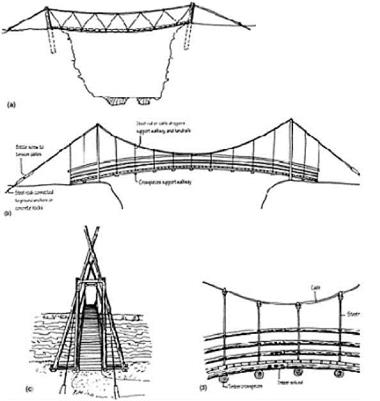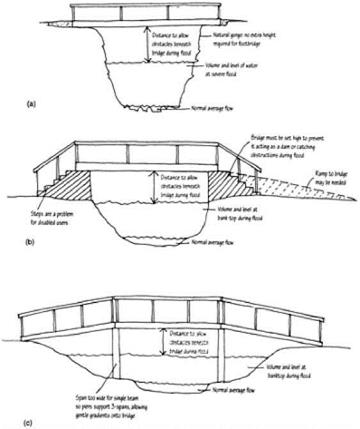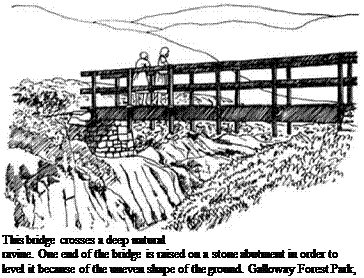Bridge decks must be set sufficiently above the water level to allow for high flood levels, and to prevent them from damming the stream with debris and causing damage nearby or the collapse of the structure. Where the stream or river is in a region with extremes of climate, flash floods can cause water levels to rise quickly, and in mountainous areas these floods carry much debris.
Beam bridges, being horizontal or only slightly arched, usually need abutments to raise them above the flood levels. If the height is more than 1 m (3 ft), ramps or low embankments will be needed to tie the ends of the bridge into the trail surface. Embankments might require culverts to release floodwaters, so they need to be considered carefully. Steps are sometimes used, but these are difficult to negotiate by visitors with disabilities. Other solutions include building the bridge on piers with more spans to enable it to start from higher places on the banks at either side. In other instances, suspension bridges might be sounder alternatives.
Abutments for footbridges are needed to support the structural beams and the deck. They must be constructed to give strength and anchorage. Wing walls may be needed to prevent erosion where the abutment meets the banks, or to contain any infill material used to make up the level. Abutments can be constructed in the following ways.
– Natural stone. If this is plentiful and part of the character of the landscape, stone abutments are ideal. Unquarried stones can be laid with concrete backfill or mortar to hold them in place. Recessed joints and grading of stones from large at the base to smaller at the top helps to tie them visually into the setting. There are opportunities for stone sculptors here.
 |
Suspension bridge construction: (a) A simple example, where one set of ropes supports the deck and a second pair provide the handrail. A good solution for wilder places. (b) A more sophisticated bridge with main support cables, droppers to support the deck and handrail and proper tensioning devices and ground anchors. (c) A view of a well-built suspension bridge from Ruunaa National Hiking Area, Finland. (d) A detail of the construction of the deck and handrail from the example at (c).
 |
Bridges and stream-flow
characteristics: (a) A bridge can rest at ground level when a deep valley gives adequate clearance. (b) A bridge should be raised above flood level in a shallow stream valley. Steps or ramps link the path to it. (c) Piers support the central span so that the outer spans can slope to meet the natural bank level.
– Gabions. Galvanized wire baskets are laid on prepared firm bases dug from the stream bank and filled with local stones, packed tightly and laid carefully against the face of the gabion mesh, ensuring that they will not fit through it. These give heavy weight and good resistance to erosion. The spaces between the baskets and the bank are backfilled with stone.
– Timber. Round timber piles, sawn timber planking or crib work (interlocked horizontal timbers) can be used to build up abutments. A piling or planking wall can be kept upright by cables fixed to ground anchors.
 |
– Concrete. Concrete on its own frequently looks out of place. If needed for structural reasons it can be cast to give it a coarse texture (using rough – sawn timber shuttering) or jack-hammered to roughen the surface. If stone construction is not sufficiently strong, shuttering can be lined with stone facing and backfilled with concrete, which gives the main strength to the bridge foundation
but maintains a more natural appearance.
Bridge handrails are not always necessary, particularly for short log beam bridges in wild settings. However, for safety and reassurance, a single or double handrail is usually necessary. The same types are appropriate as described in the previous section on boardwalks and along paths against steep drops or cliffs. Others are depicted in the illustrations for the bridges described above. The handrail should extend a little way beyond the end of the bridge to lead the eye onto the structure and tie it into the setting.
Bridge maintenance is very important. Damage by floods, erosion of the area around abutments, corrosion of steel fixings or posts, damage to decking or handrails should be checked and repaired as soon as it is discovered. Regular inspections by a qualified engineer are essential except for the smallest, simplest bridges.



